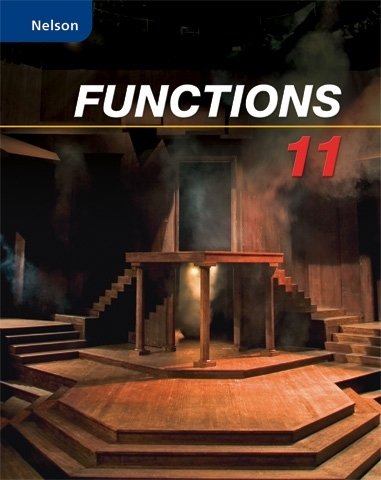
All Solutions
Page 406: Chapter Self-Test
{text{For a sinusoidal function, remember the following }} hfill \
hfill \
y = Acos left[ {kleft( {x – d} right)} right] + c{text{ }} hfill \
{text{or }} hfill \
y = Asin left[ {kleft( {x – d} right)} right] + c{text{ }} hfill \
hfill \
{text{amplitude = }}|A| = dfrac{|y_{text{max}}-y_{text{min}}|}{2}hfill \
{text{period = }}T=frac{{{{360}^ circ }}}{|k|} hfill \
{text{equation of axis:}}{text{ }},,,y = c = dfrac{y_{text{max}}+y_{text{min}}}{2} hfill \
hfill \
end{gathered} ]
b) $h_{text{max}}=5$ and $h_{text{min}}=-1$, thus, equation of axis: $h=dfrac{5+(-1)}{2}implies h=2$
c) The peaks represent the maximum height of the stair from the ground.
d) The range is the set of values from the minimum to maximum:
range: ${ hinbold{R};|;-1leq hleq 5}$
e) Ten cycles takes $10T=10times 40=400$ s
domain: ${ t inbold{R};|;0leq tleq 400}$
f) We shall find $h$ when $t=300$ s. We need to find the number of cycles at $300$ s
$dfrac{300}{40}=7.5$
Thus, $t=300$ corresponds to a half-cycle which is at $t=20$. From the graph, $h=4$. Thus, what Steven said is not correct.
b) $h=2$
c) maximum height of the stair from the ground
d) ${ hin bold{R};|;-1leq hleq 5}$
e) ${ tinbold{R};|;0leq tleq400}$
f) $h=4$ ; Steven is not correct
{text{For a sinusoidal function, remember the following }} hfill \
hfill \
y = Acos left[ {kleft( {x – d} right)} right] + c{text{ }} hfill \
{text{or }} hfill \
y = Asin left[ {kleft( {x – d} right)} right] + c{text{ }} hfill \
hfill \
{text{amplitude = }}|A| = dfrac{|y_{text{max}}-y_{text{min}}|}{2}hfill \
{text{period = }}T=frac{{{{360}^ circ }}}{|k|} hfill \
{text{equation of axis:}}{text{ }},,,y = c = dfrac{y_{text{max}}+y_{text{min}}}{2} hfill \
hfill \
{text{Generally, if the maximum point is translated $d$ units to the right of the}}hfill \\
{text{$y$-axis, the equation is $y=Acos[k(x-d)^circ]+c$}}hfill \\
{text{If the minimum point is translated $d$ units to the right of the}}hfill \\
{text{$y$-axis, the equation is $y=-Acos[k(x-d)^circ]+c$}}hfill \\
{text{Note that multiple possible sinusoidal functions can describe a graph or data}}hfill \
end{gathered} ]
$T=20implies k =dfrac{360}{20}=18$
amplitude: $A=3$
equation of axis: $c=-1$
minimum point: $c-|A|=-1-|3|=-4$
maximum point: $c+|A|=-1+|3|=2$
It is said that the graph passes through $(0,-4)$ implying that the minimum point is at the $y$-axis.
Thus, we shall use the form $y=-Acos(kx)+c$
Therefore, the equation is
$$
y=-3cos(18x)^circ-1
$$
$x=7cos 65^circapprox 2.96$
$y=7sin 65^circapprox 6.34$
Therefore, the new point is $(2.96,6.34)$
(2.96,6.34)
$$
defarraystretch{1.5}%
begin{tabular}{|l|l|}
hline
Transformation & Description \ hline
$y=f(x)+c$ & begin{tabular}[c]{@{}l@{}}vertical translation of\ $c$ units upwardend{tabular} \ hline
$y=f(x+d)$ & begin{tabular}[c]{@{}l@{}}horizontal translation of $d$ units\ to the leftend{tabular} \ hline
$y=acdot f(x)$ & begin{tabular}[c]{@{}l@{}}vertical stretching, multiplies\ the amplitude by $a$end{tabular} \ hline
$y=f(kx)$ & begin{tabular}[c]{@{}l@{}}horizontal compression, divides\ the period by $k$end{tabular} \ hline
$y=-f(x)$ & begin{tabular}[c]{@{}l@{}}reflecting the function in\ the $x$-axisend{tabular} \ hline
$y=f(-x)$ & begin{tabular}[c]{@{}l@{}}reflecting the function in \ the $y$-axisend{tabular} \ hline
end{tabular}
end{table}
[begin{gathered}
{text{For a sinusoidal function, remember the following }} hfill \
hfill \
y = Acos left[ {kleft( {x – d} right)} right] + c{text{ }} hfill \
{text{or }} hfill \
y = Asin left[ {kleft( {x – d} right)} right] + c{text{ }} hfill \
hfill \
{text{amplitude = }}|A| = dfrac{|y_{text{max}}-y_{text{min}}|}{2}hfill \
{text{period = }}T=frac{{{{360}^ circ }}}{|k|} hfill \
{text{equation of axis:}}{text{ }},,,y = c = dfrac{y_{text{max}}+y_{text{min}}}{2} hfill \
hfill \
end{gathered} ]
(1) initial function
(2) reflect over $x$-axis
(3) horizontally stretch by a factor of 2 (multiply period by 2)
(4) vertically stretch by a factor of 4 (multiply amplitude by 4)
(5) horizontally translate $90^circ$ to the left
(6) vertically translate $6$ units downwards
amplitude: $A=|-4|=4$
period: $T=dfrac{360}{|k|}=dfrac{360}{0.5}=720^circ$
equation of axis: $y=-6$
c) $f(135^circ)=-4cos[0.5(135+90)]-6approx -4.47$
d) range is the set of values from $c-|A|$ to $c+|A|$
$c-|A|=-6-|-4|=-10$
$c+|A|=-6+|4|=-2$
range: ${ f(x) in bold{R};|;-10leq f(x)leq -2}$
b) $A = 4$ , $T=720^circ$, $y=-6$
c) $f(135^circ)approx -4.47$
d) ${ f(x) in bold{R};|;-10leq f(x)leq -2}$
{text{For a sinusoidal function, remember the following }} hfill \
hfill \
y = Acos left[ {kleft( {x – d} right)} right] + c{text{ }} hfill \
{text{or }} hfill \
y = Asin left[ {kleft( {x – d} right)} right] + c{text{ }} hfill \
hfill \
{text{amplitude = }}|A| = dfrac{|y_{text{max}}-y_{text{min}}|}{2}hfill \
{text{period = }}T=frac{{{{360}^ circ }}}{|k|} hfill \
{text{equation of axis:}}{text{ }},,,y = c = dfrac{y_{text{max}}+y_{text{min}}}{2} hfill \
hfill \
end{gathered} ]
b) The periods are the same because both ends of the meter stick complete the cycle at the same time.
c) The distance of the nail from the top of the plywood is the halfway between maximum and minimum points which is the same for both graphs at $dfrac{250+110}{2}=180$ cm
d) The amplitude is the distance of each end of the meter stick from the hole (point of rotation) which is $dfrac{250-110}{2}=70$ for the longer end and $100-70=30$ for the shorter end.
e) The range is the set of $f(t)$ values from the minimum to maximum point.
short end: ${ f(t) in bold{R};|;150 leq f(t) leq 210}$
long end: ${ f(t) in bold{R};|;110 leq f(t) leq 250}$
f) Since the period is $5$ s, the time it takes for 5 revolutions is $5times 5= 25$ s
The period for both ends is:
domain: ${ tinbold{R};|;0leq t leq 25}$
short end: $A=30$, $c=180$ , maximum point is at $y$-axis $implies d=0$
$f(t)=30cos(72t)^circ+180$
long end: $A=70$ , $c=180$, the maximum point is $2.5$ s from the $y$-axis $implies d=2.5$
$f(t)=70cos[72(t-2.5)^circ]+180$
h) Evaluate $f(19)$
$f(19)=30cos(72times 19)^circ +180approx189.27$ cm
b) the same
c) $180$ cm
d) short end: 30 ; long end: 70
e) short:${ f(t) in bold{R};|;150 leq f(t) leq 210}$; long: ${ f(t) in bold{R};|;110 leq f(t) leq 250}$
f) ${ tinbold{R};|;0leq t leq 25}$
g) $f(t)=70cos[72(t-2.5)^circ]+180$
h) $189.27$ cm

